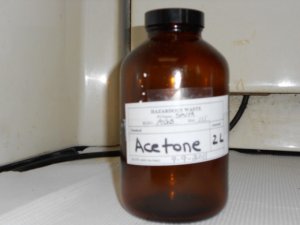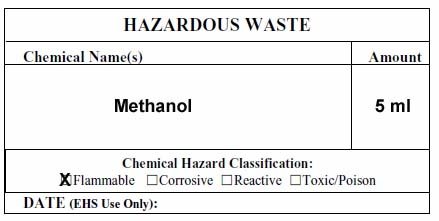Hazardous chemical wastes are regulated by the Environmental Protection Agency (EPA) under the Resource Conservation and Recovery Act (RCRA) and its amendments. Federal and state regulations promulgated under RCRA classify waste as hazardous if it meets certain criteria as specified in the regulations. If a waste is classified as hazardous, disposal must be in accordance with the regulations.
The EHSO is responsible for managing the University's Hazardous Waste Program. Funding for disposal of "common" hazardous waste streams is through the EHSO's budget. The EHSO is not funded for disposal of "uncommon" waste streams, such as unknown waste and waste requiring stabilization. The EHSO collects hazardous waste generated on campus and transfers it to a storage facility where it is properly stored until picked up by a licensed hazardous waste disposal company.
Hazardous Waste Disposal
Generators of Chemical waste are required to complete a "Request for Disposal of Hazardous Waste Form" and HazWaste Labels for their waste. The form provides information about the origination and contents of the waste. The EHSO cannot dispose of any waste whose ingredients are unknown.
Hazardous waste should be handled according to the following guidelines:
- Use the appropriate sized container for accumulating waste. For example, if only 250 ml of waste is to be generated, use a 250 - 300 ml container for accumulation.
- Use the same type of container for waste as that in which the chemical was originally shipped.
- Do not use corks or stoppers to close containers; use properly fitting screw-on lids lined with a material that will not be chemically attacked by the contents.
- Never fill containers to the top, leave 1-2 inch gap from cap.
- Do not mix hazardous and non-hazardous waste. This mixture may be regulated as hazardous.
- Avoid mixing different chemical wastes, even if they are compatible. They may each have different disposal methods.
- Do not mix hazardous and radioactive wastes; this mixture is a special waste which is difficult and very expensive to dispose of.
- Label all waste containers with HazWaste labels.
- Handle shock sensitive compounds, such as old ethers and old picric acid, with extreme caution.
Unknown Chemical waste
Laboratory personnel must make every effort to provide an accurate description of all chemicals given to EH&S for handling and disposal. Unknown chemicals will not be accepted by EH&S since they cannot be handled or disposed of in a safe manner. Hazardous waste disposal companies will not accept unknowns without proper analysis and the analysis of a single sample can easily cost $1,000 or more.
It is the responsibility of the generator (individual or department) to accurately identify all chemical unknowns in their laboratory, either by knowledge or analysis. This may require polling laboratory personnel, students and faculty members to ascertain the owner of such unknown waste and its identity. It must be constantly emphasized to researchers that they identify and label all wastes and project products.
Completing the "Hazardous Waste Disposal Request" Form
University personnel, such as Principal Investigators, lab managers and shop supervisors, are responsible for completing this form in its entirety prior to the pick up of hazardous waste.
- Fill in the name of the person requesting the pickup (contact), their department, building, room # where the waste is located, phone extension and date the form was completed.
- The "Identification of Waste" section must include the following container and contents information:
- List all contents and/or Product name and the approximate quantity or percent of each. Be sure to include water and other inert components. The total percent of the contents should equal 100 or the total volume in the container should equal the sum of the volumes of the contents. DO NOT USE ABBREVIATIONS OR CHEMICAL FORMULAS.
- The total quantity in the container (preferably in milliliters or liters for liquids and grams or pounds for solids).
- The size and type of the container (ex. 500 ml glass, 1 L plastic)
- Sign and date the form certifying that the information included on the form is accurate and to the best of your knowledge.
Completed forms should be sent to the EHSO via campus mail, email ehsdept@odu.edu or Fax (683-6025). Upon receipt of the completed form, EHSO personnel will schedule a pickup.
Labeling
A label must be completed for each container of chemical waste and affixed to the container before pick-up. Use a permanent marker to fill out the label. If an unused chemical is being disposed of, affix the hazardous waste label to the container such that the original label can still be read.
Refer to the label below while reviewing the following instructions:
- List all contents and/or Product Name. DO NOT USE ABBREVIATIONS OR CHEMICAL FORMULAS
- Give the total quantity in the container (preferably in milliliters or liters for liquids and grams or pounds for solids)
- Do not mark in the DATE area, EH&S will date the material on pick-up.
- Attach label to each chemical waste container.
- Do not cover DATE area with tape.
HazWaste Labels (cut and tape labels to containers).




